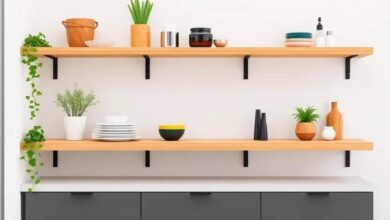Embracing the Open Plan: Transforming Modern Kitchens into Spacious Culinary Havens
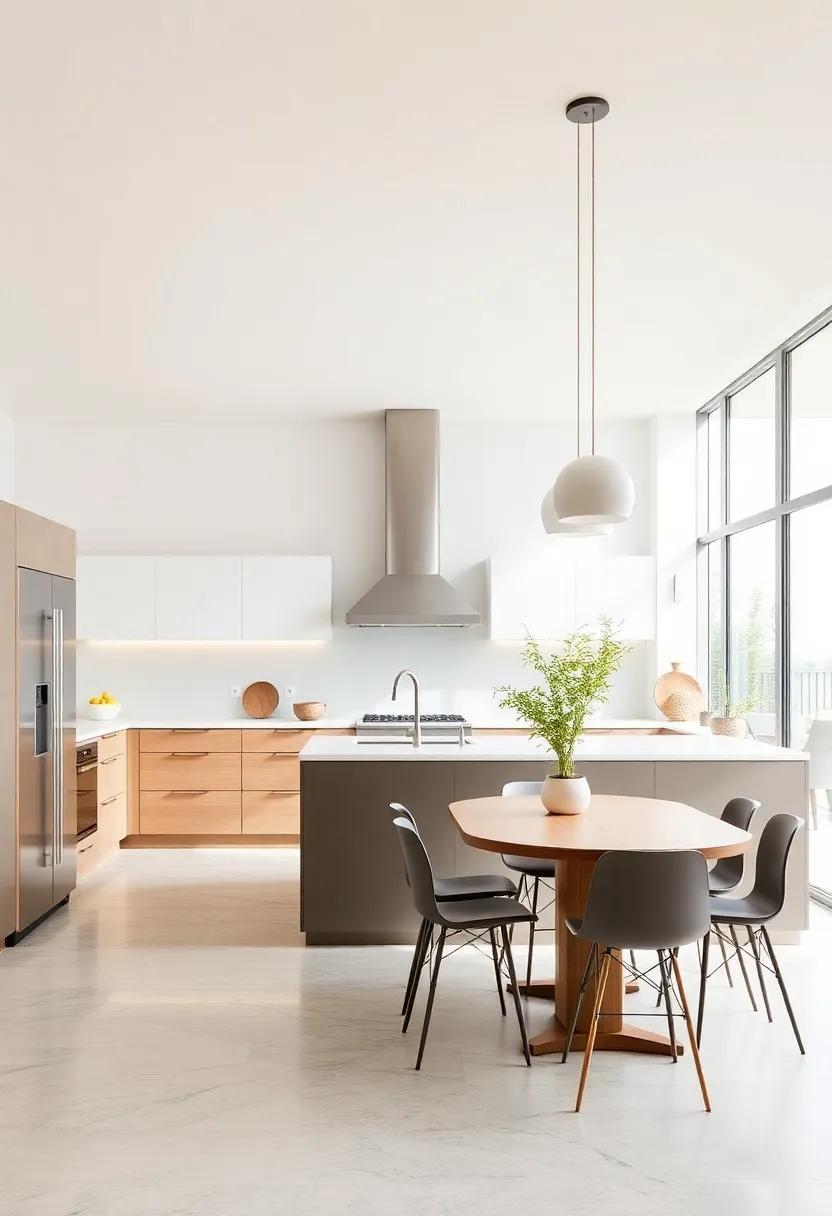
As the heart of the home, the kitchen has evolved far beyond its traditional role as merely a space for cooking and dining. In recent years, the open-plan concept has revolutionized how we envision and utilize this cherished area, fostering a seamless blend of functionality and aesthetics. Embracing the open plan means transforming our kitchens into spacious culinary havens—inviting spaces that encourage creativity,connection,and communal living. In this article, we will explore the myriad benefits of open-plan kitchens, delve into innovative design ideas, and highlight key elements that can transform your culinary space into a hub of inspiration and warmth.Whether you’re planning a renovation or simply seeking to refresh your existing layout, join us on a journey to reimagine your kitchen as a welcoming oasis of modern life.
Embracing Natural Light to Enhance Open Kitchen Spaces
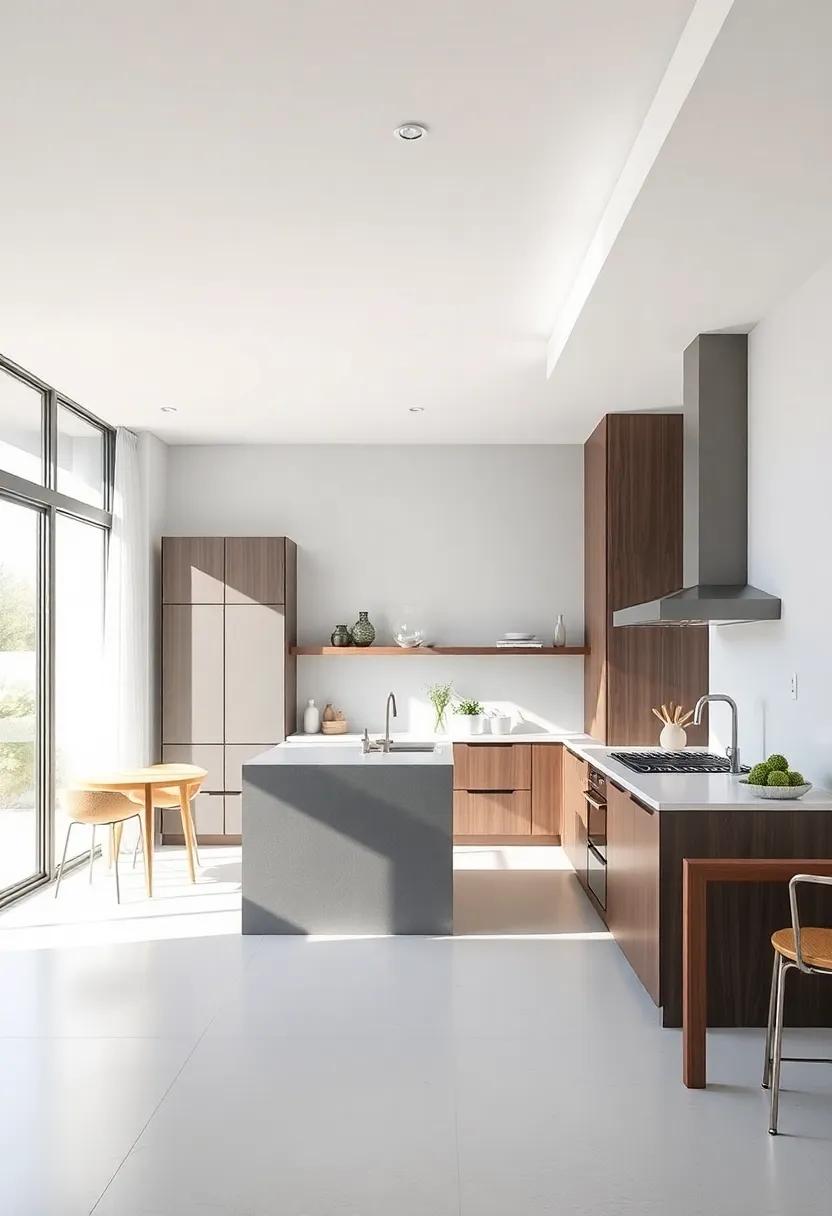
Natural light has the remarkable ability to transform the ambience of open kitchen spaces, creating an inviting atmosphere that enhances both functionality and aesthetics. By strategically utilizing windows, skylights, and glass doors, homeowners can draw in sunlight, which not only brightens the space but also highlights the kitchen’s design elements. The interplay of light and shadows adds depth, making countertops gleam and cabinetry pop. Consider these features to maximize natural light in your kitchen:
- Large Windows: Opt for floor-to-ceiling or expansive window designs that allow unobstructed views and ample sunlight.
- Transom Windows: Install these above doorways or cabinets to invite light without sacrificing privacy.
- Skylights: Harness sunlight from above to illuminate your cooking space, especially in areas with limited wall space.
Incorporating reflective surfaces further enhances the natural light, creating a dynamic and visually open habitat. Materials such as glossy tiles, stainless steel appliances, and light-colored cabinetry can amplify the sun’s rays, making the kitchen feel even more spacious. when designing your culinary haven, take into account the following aspects:
| Element | Effect on Space |
|---|---|
| Mirrors | Expand visual space and reflect light. |
| Light Colors | Make the space feel airy and open. |
| Indoor Plants | Add life and improve air quality, enhancing the natural feel. |
Integrating Seamless Indoor-Outdoor Living in Modern Kitchens
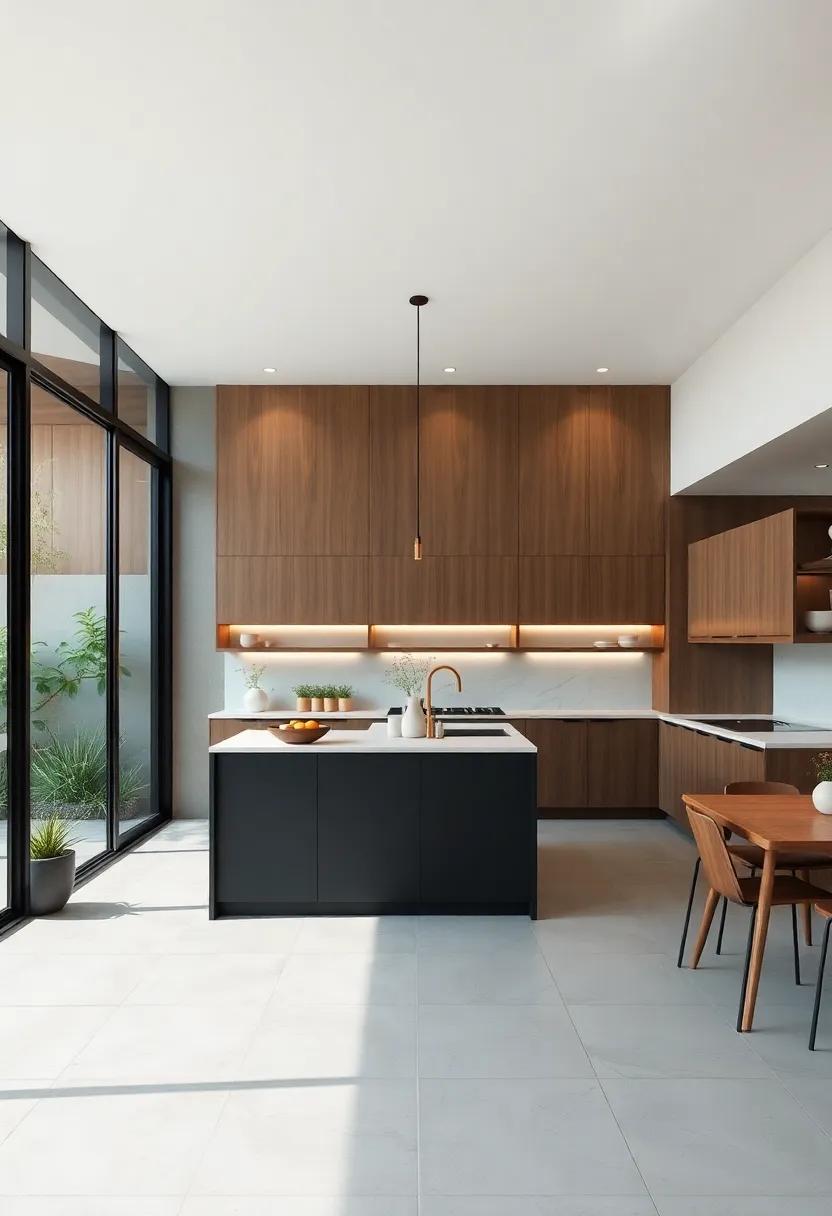
Modern kitchens are embracing the concept of seamless indoor-outdoor living, creating a harmonious transition between cooking spaces and nature.This integration is not just about aesthetics; it enhances functionality and lifestyle. With large bi-fold or sliding glass doors, homeowners can enjoy unobstructed views, making the garden feel like an extension of the kitchen. Key features enhancing this seamless connection include:
- Natural Light: Expansive windows and openings allow sunlight to flood the kitchen, making the space feel more vibrant.
- Built-In Outdoor Features: Consider outdoor cooking stations,sinks,or refrigeration that mirror indoor amenities for ease of use.
- Unified Flooring: Using the same materials for both spaces minimizes visual barriers and creates a more cohesive flow.
Moreover, incorporating elements like greenery through vertical gardens or potted herbs adds a refreshing touch, enhancing the sensory experience of cooking.Homeowners can create a relaxed ambiance with outdoor furnishings that invite casual dining and entertainment right outside the kitchen. Here’s a simple comparison of materials that are ideal for maintaining this connection:
| Material | Benefits | Considerations |
|---|---|---|
| Wood | Warmth, natural aesthetic | requires maintenance to resist the elements |
| Tile | Durability, easy to clean | Can be cold, less inviting for indoor use |
| Composite | Weather-resistant, versatile | May lack the charm of natural materials |
Choosing the Right Color Palette for an Inviting Culinary Experience

Creating a warm and welcoming atmosphere in your open-plan kitchen starts with the right color palette. A thoughtful selection of hues can evoke feelings of comfort and joy, encouraging those who enter to linger a little longer. Consider using soft, earthy tones like creamy whites, warm taupes, and gentle greens. These colors can seamlessly blend with wooden elements and natural light, amplifying the sense of space. Additionally, vibrant accents, like mustard yellows or rich terracottas, can be introduced through decor or kitchenware, providing a delightful pop that invigorates the overall aesthetic.
When combining colors, it is indeed essential to maintain a balance that promotes harmony. Opt for a 60-30-10 ratio where your primary color takes up 60% of the space, 30% is your secondary color, and 10% is used for accents. This method not only creates visual appeal but also guides the eye throughout the kitchen. Below is a simple guideline to help in visualizing your ideal color scheme:
| Color Type | Example Shades | Suggested Usage |
|---|---|---|
| Primary | Creamy White, Soft Gray | Walls, Cabinets |
| Secondary | Warm Taupe, Tranquil Sage | Countertops, Backsplash |
| Accent | mustard Yellow, Rich Terracotta | Accessories, Textiles |
Incorporating Multi-Functional Islands for Efficiency and Style
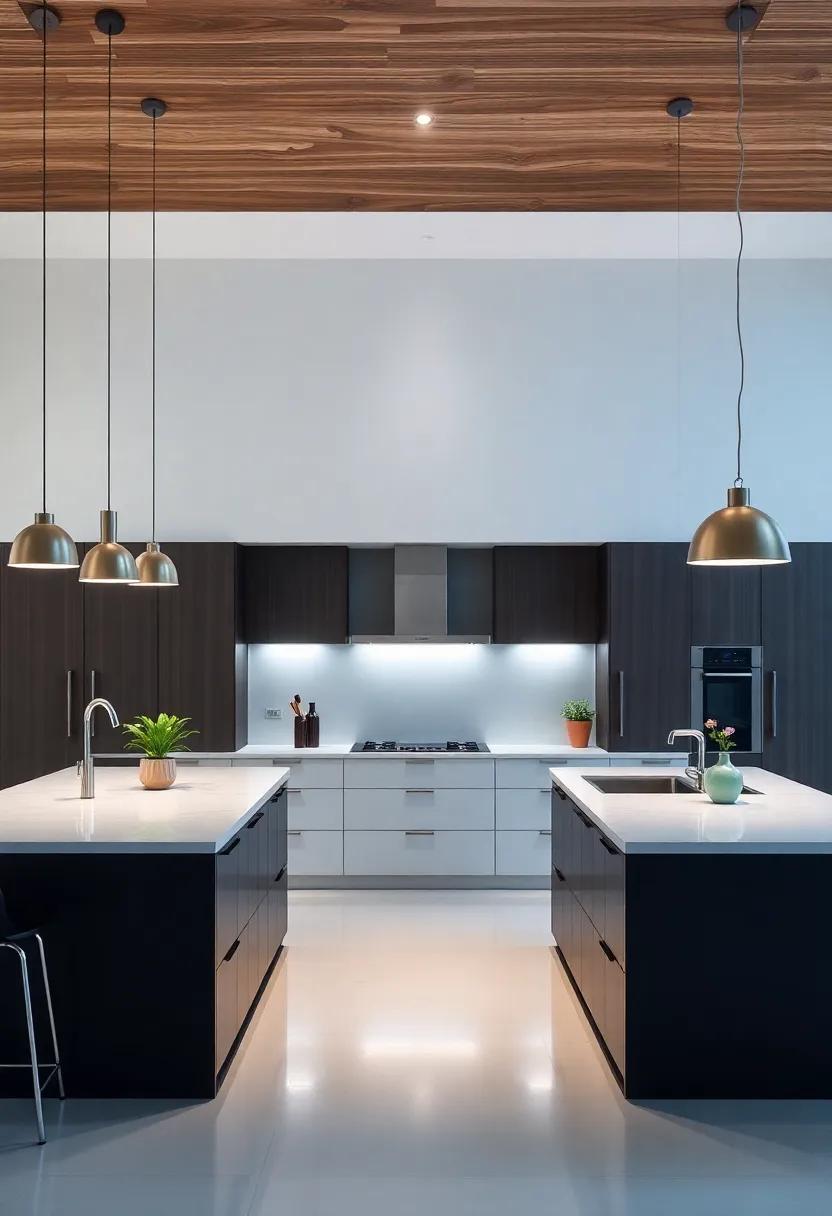
When designing an open-plan kitchen, incorporating a multi-functional island can dramatically enhance both the efficiency and aesthetic appeal of your space. These islands serve as a central hub for a variety of tasks, offering not just additional counter space, but also blending form and function seamlessly. Consider the following features to elevate your island’s utility:
- Storage Solutions: Built-in cabinets or shelves to keep kitchen essentials organized.
- Seating Areas: Bar stools or a cozy breakfast nook encourage social interaction.
- Appliance Integration: incorporate appliances like a cooktop or wine fridge for convenience.
To maximize the effectiveness of a multi-functional island, think about material choices and design elements that resonate with your overall kitchen theme. For example, a natural stone countertop can provide a striking visual contrast while remaining practical for food preparation. Additionally, consider the layout carefully, ensuring that the island complements the flow of traffic in the kitchen. A well-placed island can create distinct zones within the open-plan layout, enhancing institution and making cooking a more harmonious experience. Below is a simple guide to selecting the right features for your multi-functional island:
| Feature | Benefit |
|---|---|
| Storage Options | Declutters the kitchen environment |
| Seating Capacity | Encourages gatherings and casual dining |
| Electrical Outlets | Facilitates cooking in the modern age |
| Durable Finishes | Ensures longevity and easy maintenance |
Maximizing Storage Solutions in Spacious Open Kitchen Designs

The key to an efficient open kitchen is strategically integrating storage solutions that complement the spacious design while keeping everything within reach. When designing an open-plan kitchen, consider multi-functional furniture that serves as both a cooking area and a storage unit.Incorporate elements such as:
- Under-counter cabinets with pull-out shelves
- Island units equipped with drawers to stash kitchen essentials
- Overhead shelving that showcases decorative items while providing utility
- Built-in appliances that streamline your kitchen aesthetics and save space
Another innovative approach is to utilize vertical space through wall-mounted storage options. This not only keeps your cooking utensils and ingredients organized, but it also adds a unique design element to your kitchen. Consider the following ideas:
- Hanging pot racks that allow easy access to cookware
- Magnetic strips for knives and metallic utensils, promoting both safety and efficiency
- Open shelving where neatly arranged jars can enhance the visual appeal
Utilizing these solutions transforms your kitchen into a functional yet stylish space, ensuring you have everything at your fingertips without compromising the open feel.
Creating Cozy Nooks for Relaxation Amidst Culinary Activity
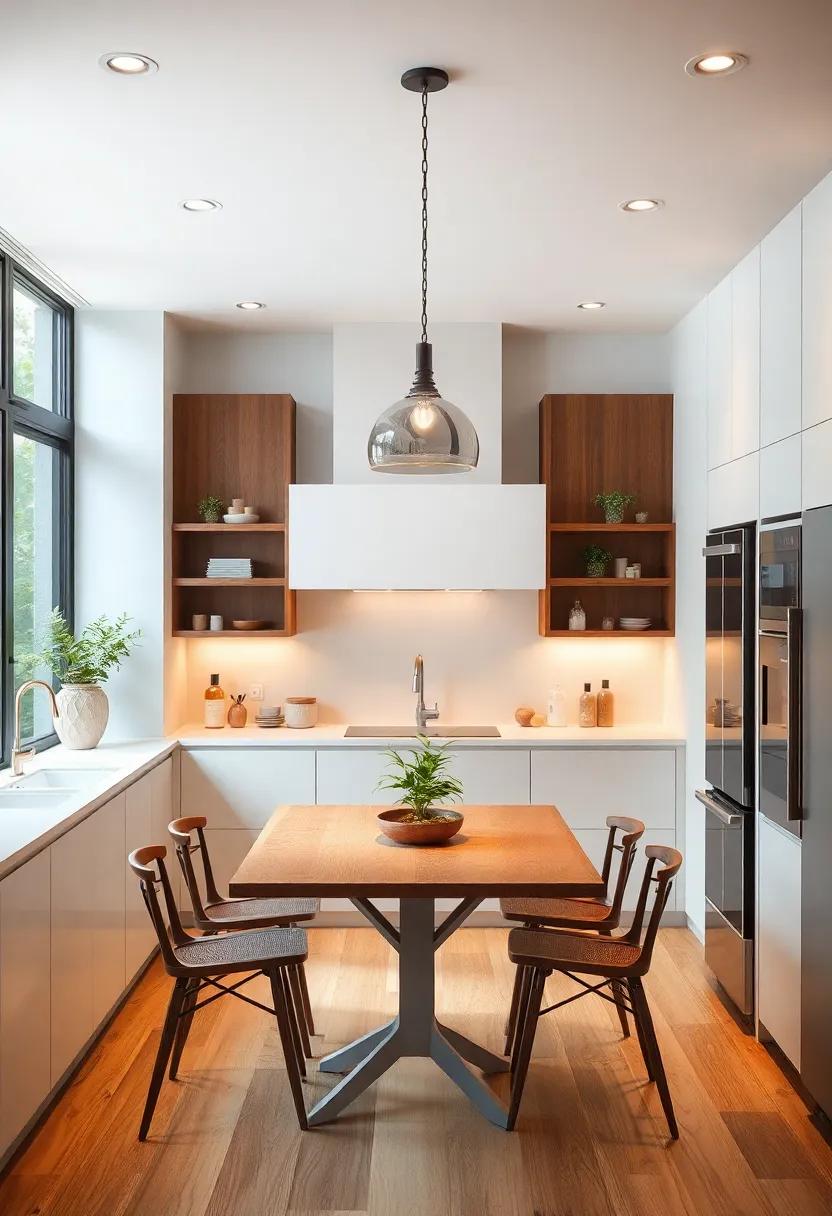
In a bustling open-plan kitchen, the aroma of spices and simmering sauces often fills the air, making a cozy nook an essential escape for relaxation. Consider crafting a small, dedicated spot where you can unwind, away from the culinary chaos. Incorporate elements such as a pleasant armchair or a quaint love seat, adorned with soft pillows and a plush throw. This inviting area can serve as a personal retreat, where you sip your favorite tea or enjoy a moment of quiet reflection. Adding a small bookshelf featuring your prized cookbooks can blend functionality with comfort, transforming the space into both a culinary hub and a serene hideaway.
To enhance the ambiance, you might want to incorporate ambient lighting options like wall sconces or a hanging pendant above your nook, casting a warm glow that makes the area feel welcoming. Surrounding the nook with greenery, such as small potted herbs or succulents, not only purifies the air but also brings a touch of nature indoors. Consider using a stylish side table for your books or refreshments,and don’t forget to personalize the space with artwork or photographs that inspire creativity.The balance of culinary activity and tranquil escape can be beautifully achieved, fostering an environment where cooking feels less like a chore and more like a joyful experience.
Fostering Social Connections with Open Kitchen Layouts
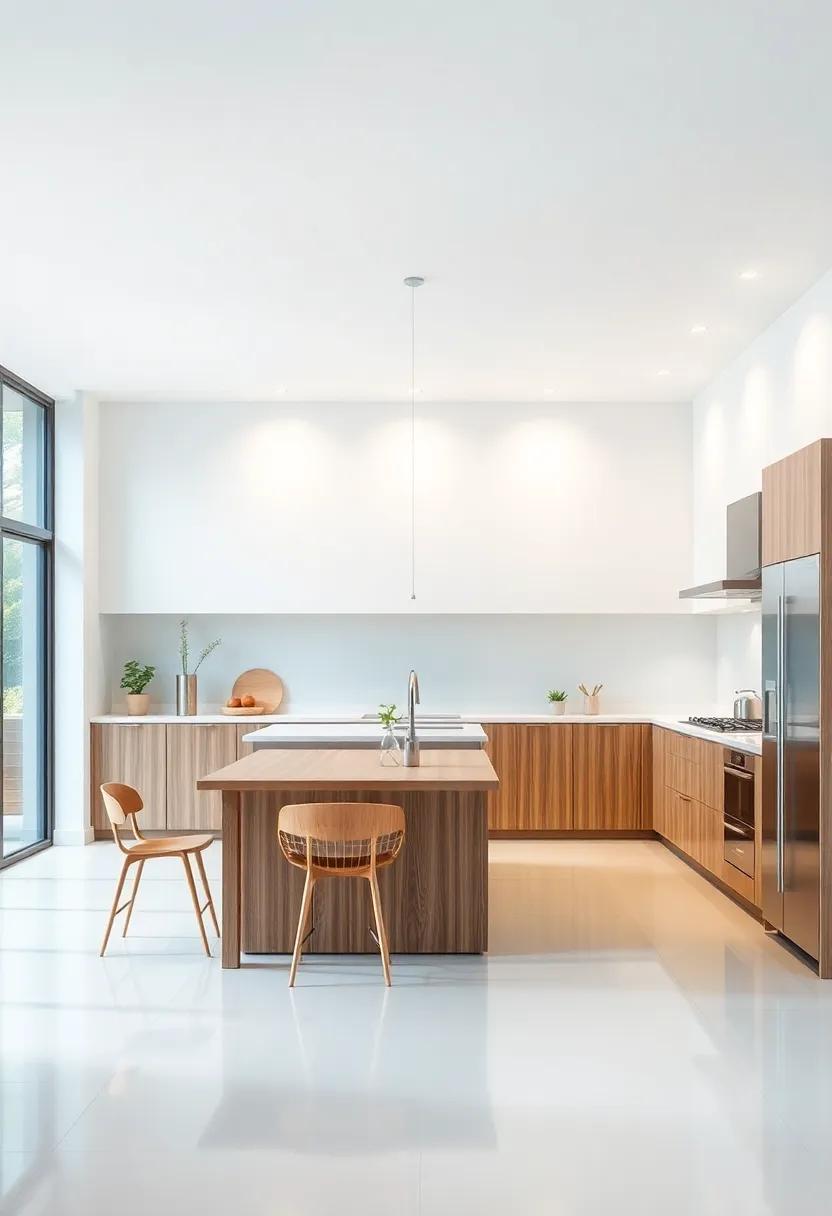
The open kitchen layout serves as a welcoming space that transcends mere functionality, inviting family and friends to gather and engage in the heart of the home. This design fosters a sense of connection and collaboration as culinary enthusiasts can showcase their skills while engaging in conversation. With features like seating islands, breakfast bars, and integrated dining areas, the kitchen becomes a dynamic environment where cooking transforms into a shared experience. here are a few ways in which the open layout encourages social interaction:
- enhanced Visibility: Chefs can easily communicate with guests, making cooking more interactive.
- Seamless Flow: Movement between spaces is fluid, allowing for easy transitions from cooking to dining.
- Shared Activities: Cooking together becomes a fun activity, strengthening bonds among family and friends.
Moreover, the elimination of barriers creates a vibrant atmosphere perfect for entertaining. The kitchen island, often the centerpiece, not only provides additional prep space but also acts as a social hub where guests can sit and chat while meals are underway. This interaction is further enhanced by thoughtful design elements such as open shelving that displays beautiful dishware, making it easier for hosts to include their guests in the dining experience. The following table illustrates the key benefits of an open kitchen layout:
| Benefit | Description |
|---|---|
| Increased Engagement | More opportunities for guests to participate in meal preparation. |
| Improved Communication | Better interaction between the cook and the guests. |
| Enhanced entertaining | A perfect setup for hosting friends and family gatherings. |
Selecting Durable and stylish Materials for High-Use Areas

When designing high-traffic areas in your open plan kitchen, selecting the right materials can make all the difference in both functionality and aesthetics. Durable choices such as quartz, granite, and porcelain tiles not only withstand the rigors of daily use but also add a touch of elegance to your space. Consider incorporating elements like:
- Scratch-resistant surfaces to maintain a polished look.
- Waterproof finishes to combat spills and splashes.
- Heat-resistant materials for areas near ovens and stovetops.
For cabinetry and countertops, it’s essential to balance durability with style.Wood veneers and laminates can offer warmth and sophistication while being affordable and practical. When considering flooring options, look for materials like vinyl plank or engineered hardwood, which are trendy yet capable of handling high foot traffic. A helpful comparison of popular materials is shown below:
| Material | Durability | Style Points | Maintenance |
|---|---|---|---|
| Quartz | high | Elegant | Minimal |
| Granite | Very High | Classic | moderate |
| Porcelain Tiles | High | Versatile | Easy |
| Vinyl Plank | Medium | Modern | Low |
Balancing Aesthetics and Functionality in Kitchen Workspaces

In the contemporary kitchen, achieving a harmonious blend of style and practicality is essential for enhancing the culinary experience. An open-plan layout frequently enough invites a natural flow, allowing light and space to define the workspace. To ensure that aesthetics and functionality are successfully intertwined, consider the following elements:
- High-quality materials: Use durable surfaces like quartz or butcher-block countertops that resist wear while adding visual appeal.
- smart storage solutions: Integrate cabinetry that combines elegance with innovation, such as pull-out shelves and hidden compartments.
- Natural lighting: Maximize window placements or skylights to illuminate your kitchen and create an inviting atmosphere.
While the visual aspects contribute to the kitchen’s charm, it’s crucial to prioritize functional elements that simplify cooking and multitasking. Engaging design can also elevate usability, as outlined in the table below:
| Feature | Description |
|---|---|
| Ergonomic Layout | A design that minimizes unnecessary movements, promoting efficiency. |
| Appliance Accessibility | Strategically placed appliances reduce hassle and enhance workflow. |
| Adjustable Lighting | Layered lighting options support various tasks while enhancing ambiance. |
Highlighting Innovative Appliances for a Sleek Modern Kitchen
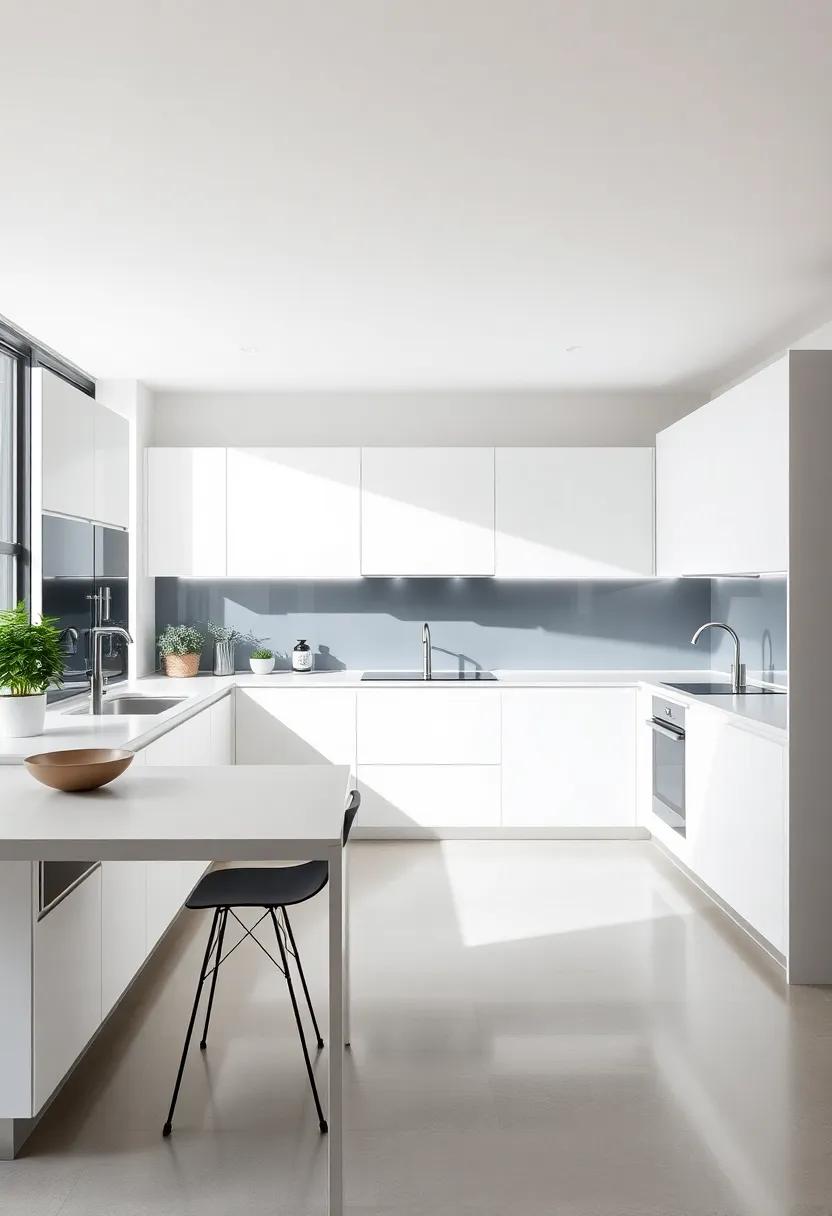
In the realm of modern cuisine, innovative appliances elevate both functionality and design, seamlessly blending advanced technology with aesthetic appeal. Take, for instance, the smart refrigerator, equipped with touch screens and integrated cameras, allowing you to check the contents from your phone while grocery shopping. Other remarkable items such as induction cooktops, known for their speedy heating and energy efficiency, make cooking a delight in an open-plan setting. Additionally, the emergence of smart ovens with app connectivity enables precise cooking at your fingertips, ensuring that your culinary creations are always on point.
Complementing these advancements are sleek dishwashers designed to operate quietly while maintaining high performance, preserving the serene ambiance of an open kitchen. The integration of built-in coffee makers not only provides your daily brew at home but also contributes to a modern, uncluttered aesthetic. below is a brief overview of other innovative appliances to consider:
| Appliance | Feature | Benefit |
|---|---|---|
| Smart Refrigerator | Touch screen & camera | Convenient inventory management |
| Induction Cooktop | Quick-heating technology | Energy-efficient cooking |
| Smart Oven | App connectivity | Remote monitoring & precise cooking |
| Quiet Dishwasher | Noise reduction technology | Maintains peaceful kitchen environment |
| Built-in Coffee Maker | Integrated design | Maximizes counter space |
Designing Open Shelving for Easy Access and Visual Appeal
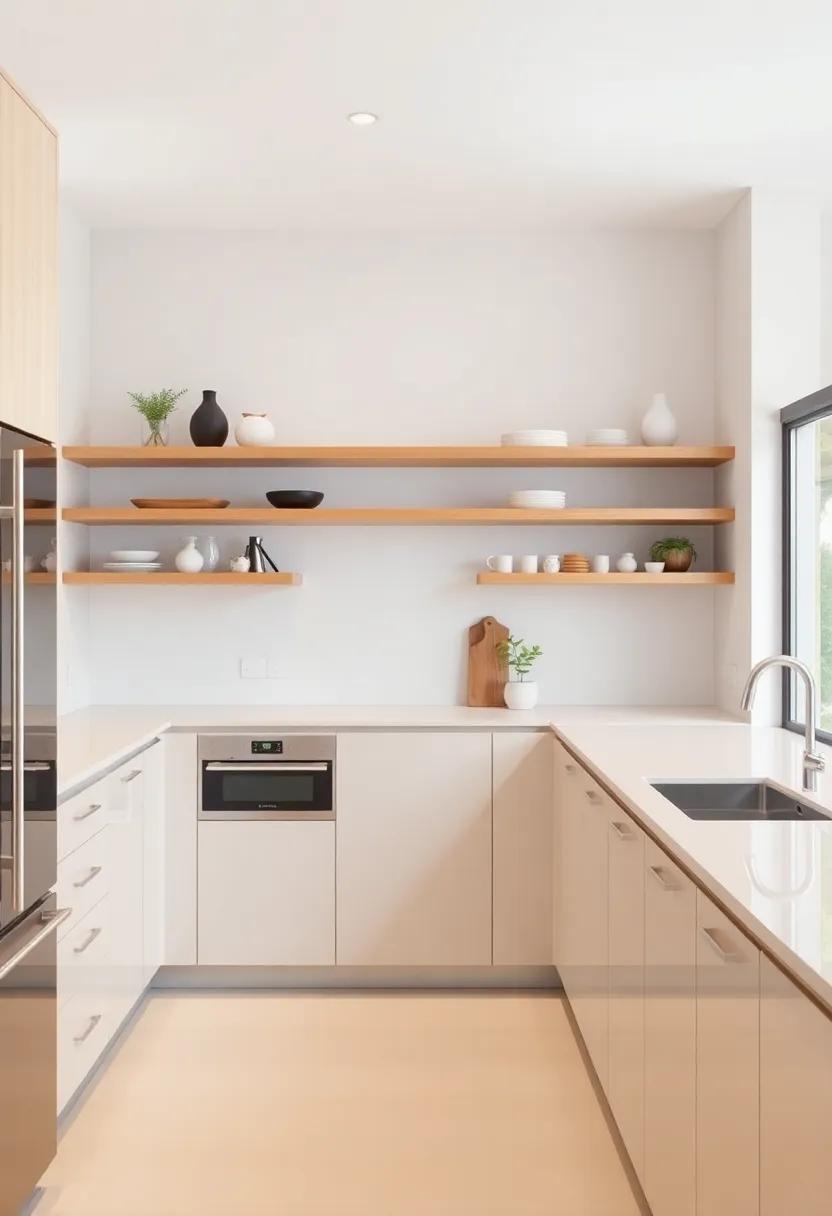
When designing open shelving, the key is to strike a balance between accessibility and aesthetics.Start by choosing a location that allows for effortless reach while cooking or entertaining.Consider the following options for your open shelves:
- For frequently used items: Position shelves near the stove or prep area to keep essential cookware and utensils within easy grasp.
- Decorative elements: Use higher shelves for beautiful dishware or seasonal decor that adds a personal touch without obstructing functionality.
- Layering: Incorporate various heights and depths in your shelf arrangement to create visual interest.
Visual appeal also plays a vital role in the success of your shelving design. Utilize baskets, jars, and dividers to keep items organized and stylishly displayed. To tie the look together, coordinate colors and materials that complement your kitchen’s overall design. Here are some tips to enhance visual cohesion:
- Color palette: Stick to a cohesive color scheme to prevent a cluttered appearance.
- Material mixing: Combine wood, metal, and ceramic for texture without overwhelming the senses.
- Balance: Distribute heavier items evenly to maintain a harmonious look.
Incorporating Greenery to Bring Life into Open Kitchen Areas
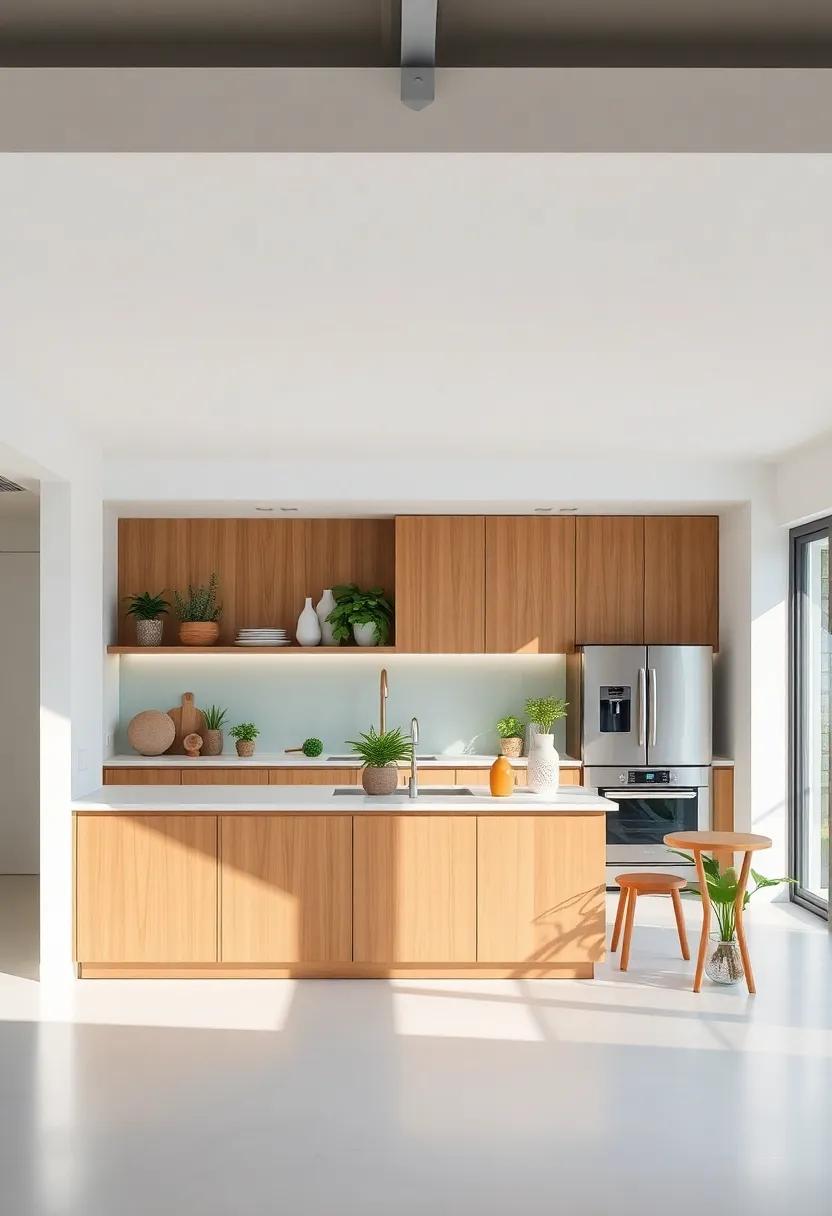
Bringing greenery into your kitchen can transform the space from a mere culinary area into a vibrant oasis. Plants not only enhance the aesthetic appeal but also purify the air, making your cooking experience more invigorating. Consider these ideas to seamlessly merge nature with your open kitchen design:
- Herb Garden: Install wall-mounted planters or windowsill pots for fresh herbs like basil, cilantro, and thyme. They are convenient for cooking and add a beautiful pop of green.
- Hanging Plants: Utilize vertical space with hanging pots from the ceiling or upper shelves, allowing tendrils of greenery to cascade down and create depth.
- Variety of Textures: Mix different plants such as succulents,ferns,and pothos to introduce various textures and colors that keep the space visually engaging.
When selecting the right plants for your kitchen, consider those that thrive in low light and require minimal maintenance. Here’s a quick overview of popular kitchen-friendly plants:
| plant Name | Light Requirements | Care Level |
|---|---|---|
| Spider Plant | Indirect sunlight | Easy |
| Pothos | Low to bright light | Easy |
| Herbs | Direct sunlight | Moderate |
| Snake Plant | Indifferent | Very Easy |
Exploring Creative Lighting Solutions for Culinary Hubs

In the heart of an open-plan kitchen, lighting can redefine the atmosphere, transforming a utilitarian space into an elegant culinary haven. Consider integrating task lighting to serve functional needs, ensuring that essential areas like countertops and stove tops are well-illuminated. Accent and ambient lighting contribute to the overall aesthetic, adding warmth and character to the décor.Here are several creative options to explore:
- Pendant Lights: Hang unique fixtures over islands or dining areas to create a focal point.
- Under-cabinet Lighting: Install LED strips to brighten workspaces and enhance textures of countertops.
- Track Lighting: Utilize adjustable systems to highlight art pieces or architectural features.
- Smart Lighting: Incorporate technology that allows you to adjust brightness and color temperature based on the time of day or mood.
When designing the lighting layout, consider the importance of layering to achieve depth and dimension.A balanced approach to different types of lighting helps maintain a functional yet inviting environment. To illustrate the relationship between lighting styles and their effects, the table below summarizes key features:
| Lighting Type | Purpose | Ideal Placement |
|---|---|---|
| Task Lighting | Illuminate work areas | Above counters, stoves |
| Accent Lighting | Highlight features | On shelves, artwork |
| Ambient Lighting | Create overall warmth | Throughout the kitchen |
utilizing Textures to Add Warmth and Character to Kitchens

Incorporating a variety of textures into open-plan kitchens not only enhances their visual appeal but also creates an inviting ambiance. Think about layering materials to evoke a sense of comfort and sophistication. Consider these options:
- Natural Wood: Wooden cabinetry or shelving adds warmth, making the kitchen feel cozy and grounded.
- Textured Stone: Introducing stone countertops or tiled backsplashes can provide a unique tactile contrast to smooth surfaces.
- Textiles: Soft furnishings, such as seat cushions or draped fabrics, introduce softness and can easily be changed with seasons.
Additionally, mixing finishes can substantially impact the overall aesthetic. For instance, a combination of matte and glossy surfaces can create visual intrigue, while different color tones can help define distinct areas within the open space. A simple table summarizing popular texture combinations might look like:
| texture Type | Suggested Pairing |
|---|---|
| Rustic Wood | Slick Quartz Countertops |
| Brushed Metal | Soft Fabrics |
| Glossy tiles | Matte Finishes |
Establishing Flow Between Kitchen and Living Areas for Cohesion
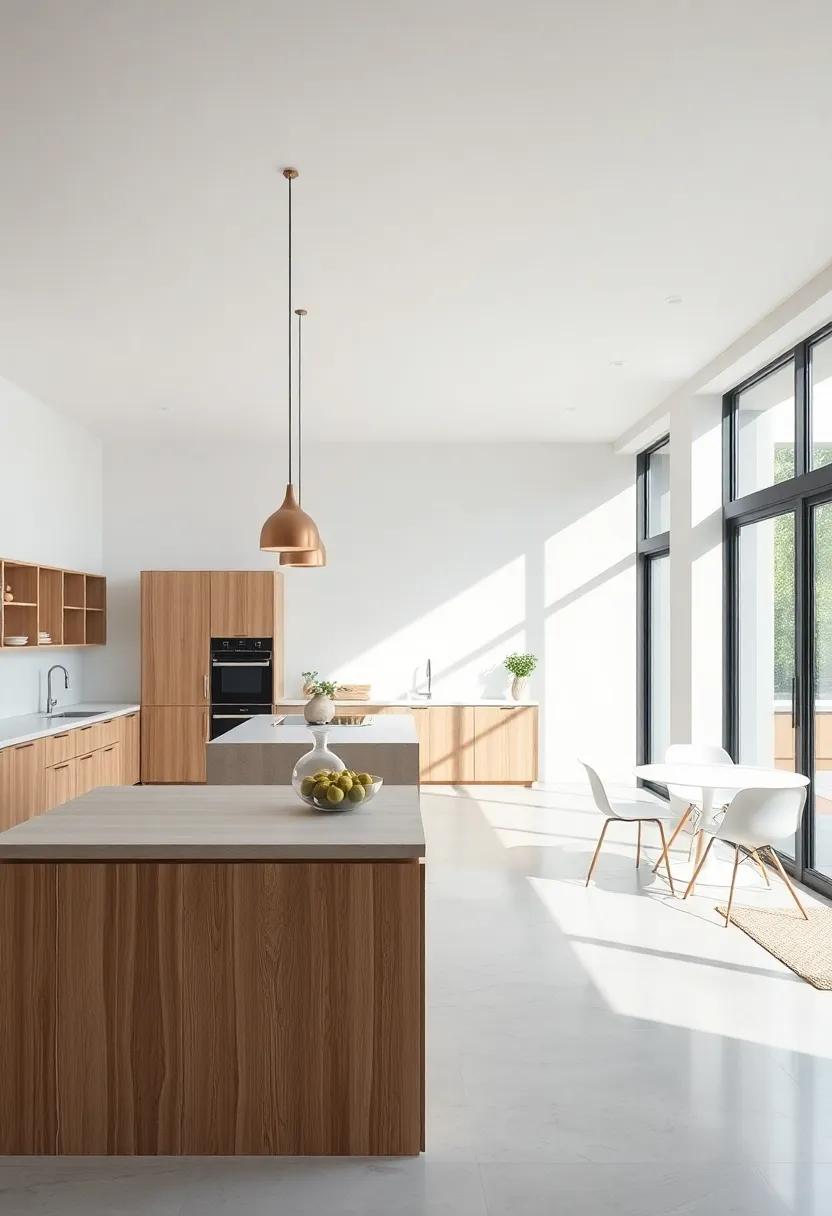
Achieving a seamless transition between the kitchen and living areas is vital for creating a harmonious open plan design. This style not only enhances the aesthetic appeal but also promotes interaction and flow among family members and guests. to facilitate this connection:
- Use Consistent Flooring: Selecting the same flooring material throughout both spaces can visually unify them.
- Incorporate a Central Island: A multifunctional island can serve as a dividing yet connecting element,allowing for both prep space and casual dining.
- Open Sight Lines: remove unnecessary walls or barriers to maintain visibility, ensuring that the kitchen feels inviting and integrated with the living area.
The choice of color palette and decor also plays a crucial role in this cohesion. Using complementary colors and design elements can help tie both areas together, making the transition feel natural. Consider the following strategies:
| Element | integration Strategy |
|---|---|
| Color | match wall colors or choose a contrasting focal hue for accents. |
| Furniture | Select pieces that reflect similar design styles for both areas. |
| Lighting | Use complementary fixtures or pendant lights to unify the ambiance. |
Crafting a Personalized Culinary Haven with Unique Decor

To create a culinary haven that reflects your unique personality, focus on incorporating distinctive decor elements that elevate the aesthetic appeal of your kitchen. By blending functional pieces with artistic designs, you can set a warm and inviting atmosphere.Consider adding:
- Custom Wall Art: Showcase local artists or personal photographs that capture your culinary adventures.
- Unique Lighting Fixtures: Opt for pendant lights or vintage chandeliers that serve both form and function, casting a cozy glow.
- herb Wall Planters: Bring in greenery and fresh scents by creating vertical gardens with herbs in charming pots.
another way to infuse character into your kitchen is by curating a collection of handmade kitchenware and utensils. These can serve as both tools and decorative pieces. Consider displaying items like:
| Item | Purpose |
|---|---|
| Artisan Cutting Boards | Functional and beautiful surfaces for food prep. |
| Handcrafted pottery | Serving dishes that add a personal touch to meals. |
| Vintage Utensils | Serve as conversation starters and decorative accents. |
Encouraging Collaboration with an Open and Inviting Layout
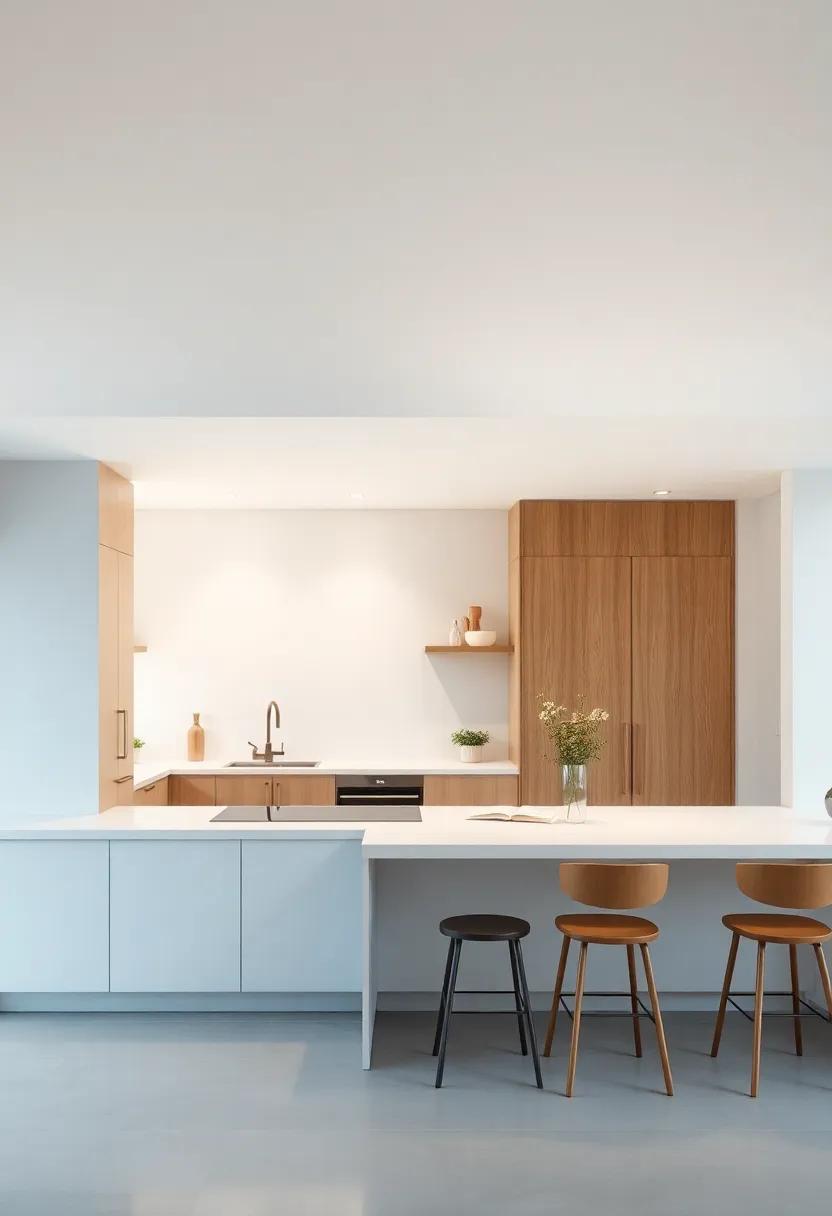
Creating a kitchen that fosters collaboration is all about the layout.An open design encourages family members and guests to interact, cook together, and share culinary experiences. By incorporating elements such as a spacious island or a multi-functional bar, you not only enhance the workflow but also create a gathering place. Consider these features:
- Central Island: A hub for meal prep and socializing.
- Seating Options: Stools or benches that invite conversation.
- Transparent Layout: Clear sightlines that connect the kitchen with dining and living areas.
Moreover, integrating flexible storage solutions can further inspire creativity and efficiency. An organized kitchen ensures that collaboration flows seamlessly, making it easier for everyone to contribute to meal preparation. Imagine a layout that incorporates:
| Storage Feature | Benefit |
|---|---|
| pull-out Pantry | Maximizes space and accessibility. |
| Open Shelving | Showcases beautiful dishware and spices. |
| Drawer Dividers | Streamlines utensils for easy access. |
Investing in Smart Technology to Elevate Kitchen Experience
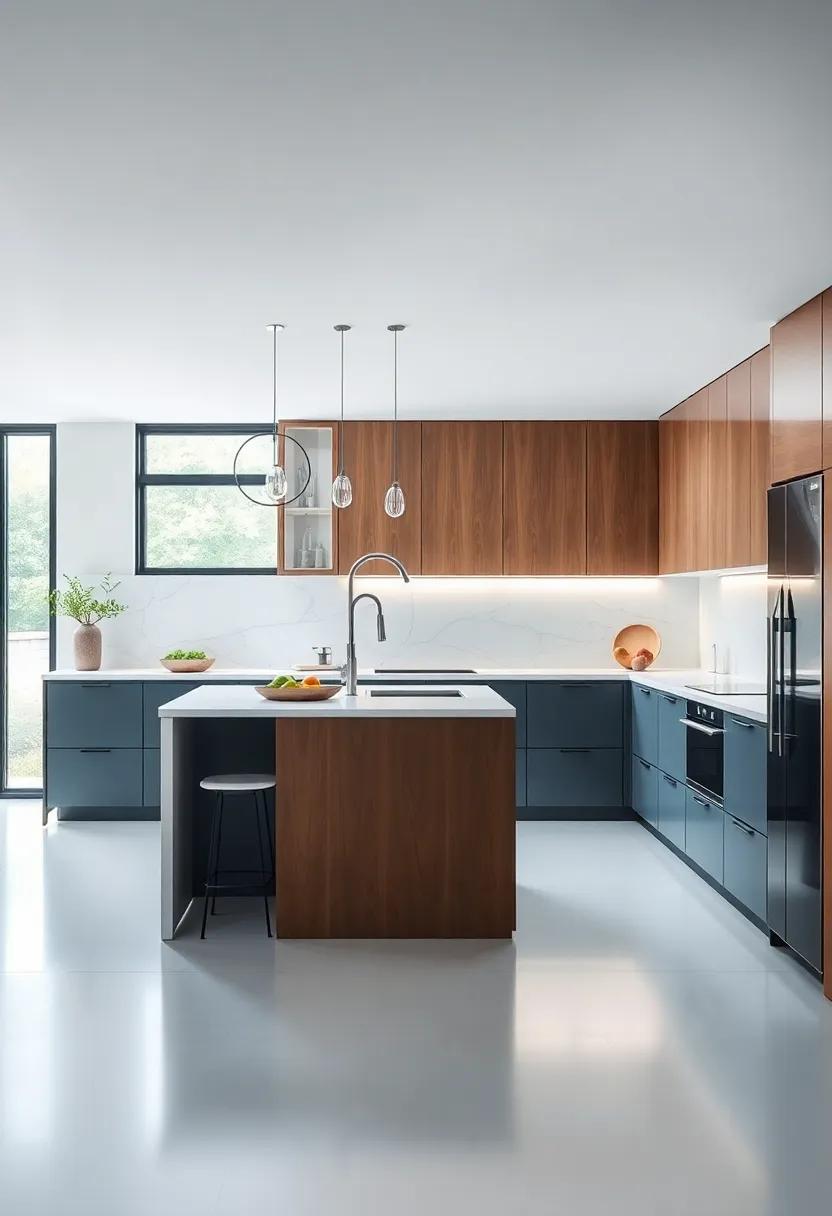
In today’s culinary landscape, integrating smart technology is essential for creating an efficient and enjoyable kitchen space. With an increasing number of households opting for open-plan designs, the adoption of innovative gadgets can significantly enhance the cooking experience. Imagine having an clever refrigerator that not only keeps track of your grocery inventory but also offers recipe suggestions based on what’s inside. These high-tech appliances are not just about convenience; they save time and reduce food waste, turning meal prep into a seamless experience.
Moreover, smart home systems can control various kitchen elements with ease, integrating lighting, temperature, and appliance management all in one place. Some features to consider include:
- Voice-activated assistants: Manage your kitchen tasks hands-free with voice commands.
- Smart oven technology: Preheat your oven remotely or adjust cooking settings via an app.
- Wi-Fi-enabled coffee makers: Start brewing your coffee from your bedroom, ensuring it’s ready by the time you get to the kitchen.
As technology evolves, the chance to create a kitchen that caters to both efficiency and comfort becomes a reality. Embracing these advancements transforms the culinary experience, making modern kitchens a hub for innovation and creativity.
Reflecting Personal Style Through Custom Open Kitchen Features
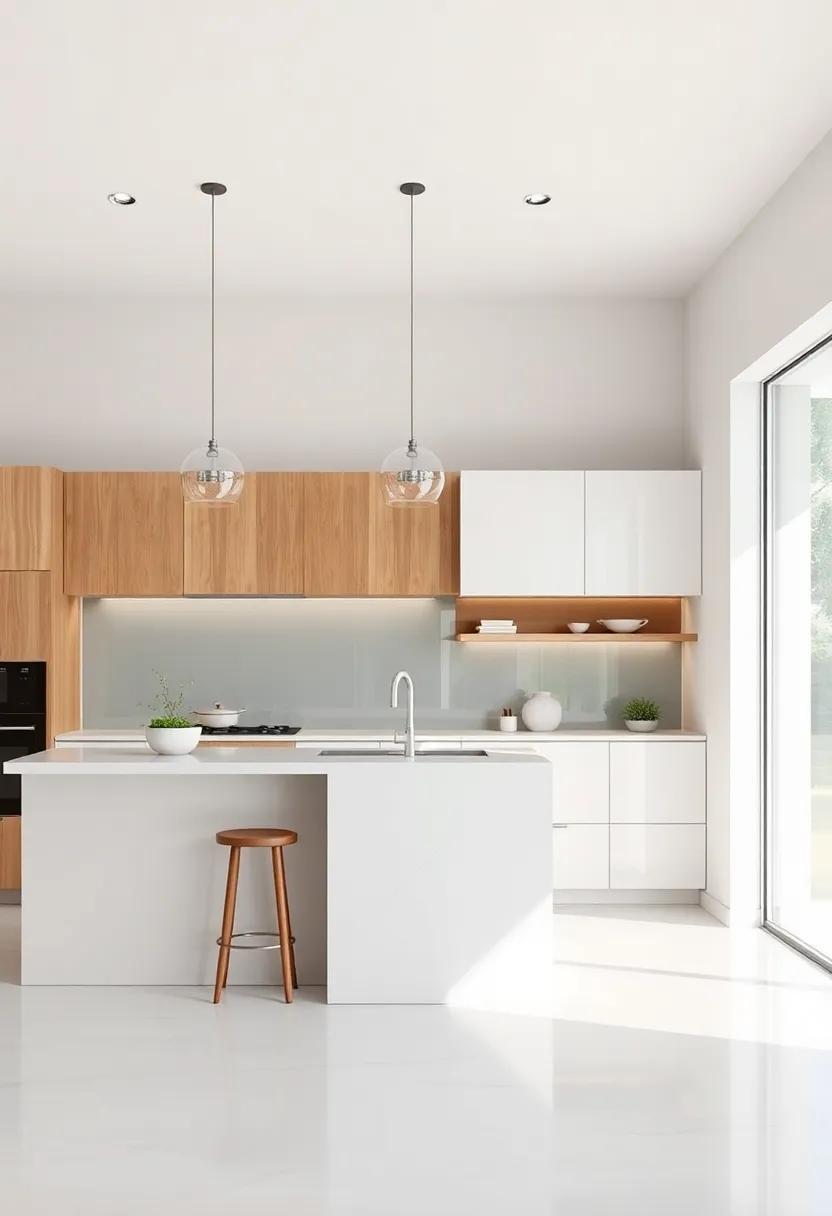
Custom open kitchens offer a blank canvas for expressing individual taste, creating spaces that are as functional as they are beautiful. Homeowners can incorporate unique design elements, such as:
- Personalized cabinetry: Choose finishes and hardware that reflect your aesthetic.
- Statement backsplashes: Use bold colors or intricate patterns to make a visual impact.
- Artistic lighting: Install striking fixtures that double as design focal points.
- Custom islands: tailor the size and shape to meet both cooking and socializing needs.
Moreover, the integration of custom features can enhance the culinary experience, blending practicality with style. Consider the following aspects:
| Feature | Benefit |
|---|---|
| Open Shelving | Encourages accessibility and displays favorite dishes or cookbooks. |
| Built-in Herb Garden | Provides fresh ingredients and enhances the kitchen’s aesthetic. |
| Multifunctional Bar Area | Serves guests and offers additional prep space for cooking. |
Ensuring comfort and Accessibility in Spacious Kitchen Designs
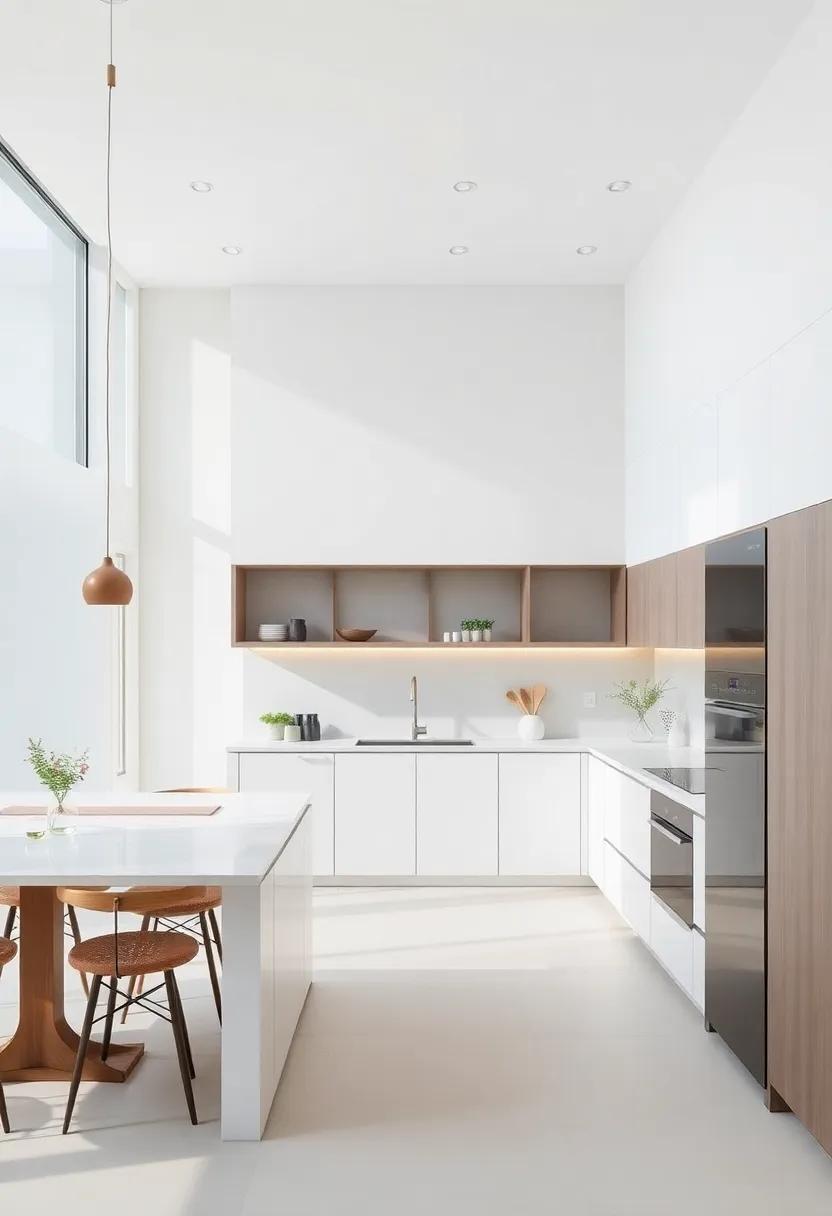
Designing a spacious kitchen that prioritizes comfort and accessibility involves thoughtful planning and the right selection of elements. Key considerations include ergonomic layouts that allow for easy movement and workflow, as well as adjustable features that cater to users of all abilities. To achieve this, it’s essential to integrate elements such as:
- Wide pathways to accommodate multiple users.
- Accessible countertops at varying heights.
- Smart storage solutions,ensuring everything is within reach.
- Slip-resistant flooring for added safety.
In addition, incorporating technology can enhance both comfort and accessibility. Consider utilizing smart appliances that offer voice control or mobile app interfaces, allowing for seamless operation without excessive movement. Furthermore, adjustable lighting plays a crucial role—select fixtures that provide both ambience and task lighting, tailored to different cooking scenarios. A well-planned layout can include:
| Feature | Benefit |
|---|---|
| Touch-free faucets | Enhances cleanliness and ease of use |
| Pull-out cabinets | Maximizes accessibility and organization |
| Soft-close drawers | prevents slamming, enhancing safety |
| Adjustable shelving | accommodates different needs and items |
Creating a harmonious Color Scheme that Unifies the Space
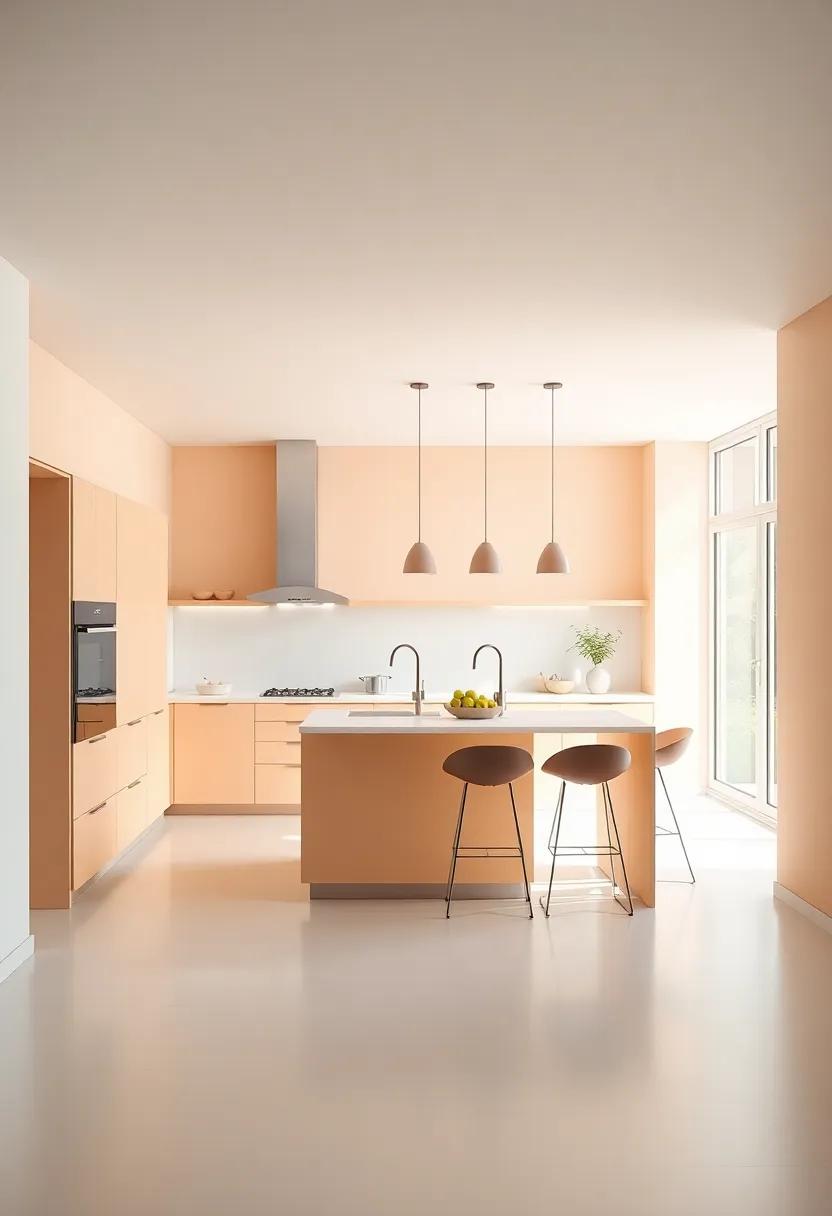
When transforming your kitchen into a spacious culinary haven, one of the most crucial steps is to create a color scheme that resonates throughout the open plan. A unifying color palette can significantly enhance the flow between the kitchen and adjacent living areas, making them feel cohesive and inviting. Begin by selecting a base color that reflects your personal style—this could range from warm earthy tones to cool ocean hues. Once the base is chosen, consider adding complementary shades that can be applied to cabinetry, countertops, and accents to build depth and visual interest.
To maximize the harmonious effect, you can incorporate design elements that echo the chosen colors across the space. Here are some effective approaches to achieve this:
- Accent Walls: Use a bold color for a feature wall that connects the kitchen with the dining or living area.
- Textiles: Introduce fabrics,such as cushions or rugs,that feature your color palette to create links throughout the space.
- Ceramics and Accessories: Enhance your culinary haven with dishware and decorative items that mirror your selected hues.
To help visualize your ideas, reference the following color example table:
| Color | Use Cases | Complementary shades |
|---|---|---|
| Soft Sage Green | Cabinetry, Backsplash | Muted Cream, Light Gray |
| Rich Terracotta | Accent Wall | Warm Beige, Olive Green |
| Cool Nautical Blue | Accessories, Textiles | white, Sandy Taupe |
Exploring Culinary Zones for Organized Cooking Experiences

The beauty of an open-plan kitchen lies in its capacity to create distinct culinary zones that enhance both efficiency and creativity. By defining areas for prep, cooking, serving, and clean-up, home cooks can move seamlessly from one task to another while engaging with family and guests.Establishing these zones not only optimizes workflow but also fosters an inviting atmosphere where culinary adventures can thrive. Imagine a designated island for chopping fresh ingredients, a stovetop surrounded by spices and utensils, and a cozy nook for enjoying the fruits of your labor—all within sight and reach.
To elevate these culinary zones, consider incorporating elements that sharpen functionality while adding personal flair. Here are some ideas to consider:
- smart Storage Solutions: Utilize cabinets with pull-out shelves, lazy Susans, and built-in dividers for easier access to kitchen tools and ingredients.
- Lighting Features: Install task lighting above work areas and ambient lighting to create warmth during social gatherings.
- Mobile Carts: Place a rolling cart nearby for easy mobility,serving as a station for herbs,sauces,and frequently used tools.
The incorporation of these elements effortlessly turns a traditional kitchen into a multifunctional space where cooking becomes more than just a chore—it’s a shared experience.
Incorporating Artistic Elements for Visual Interest and Charm
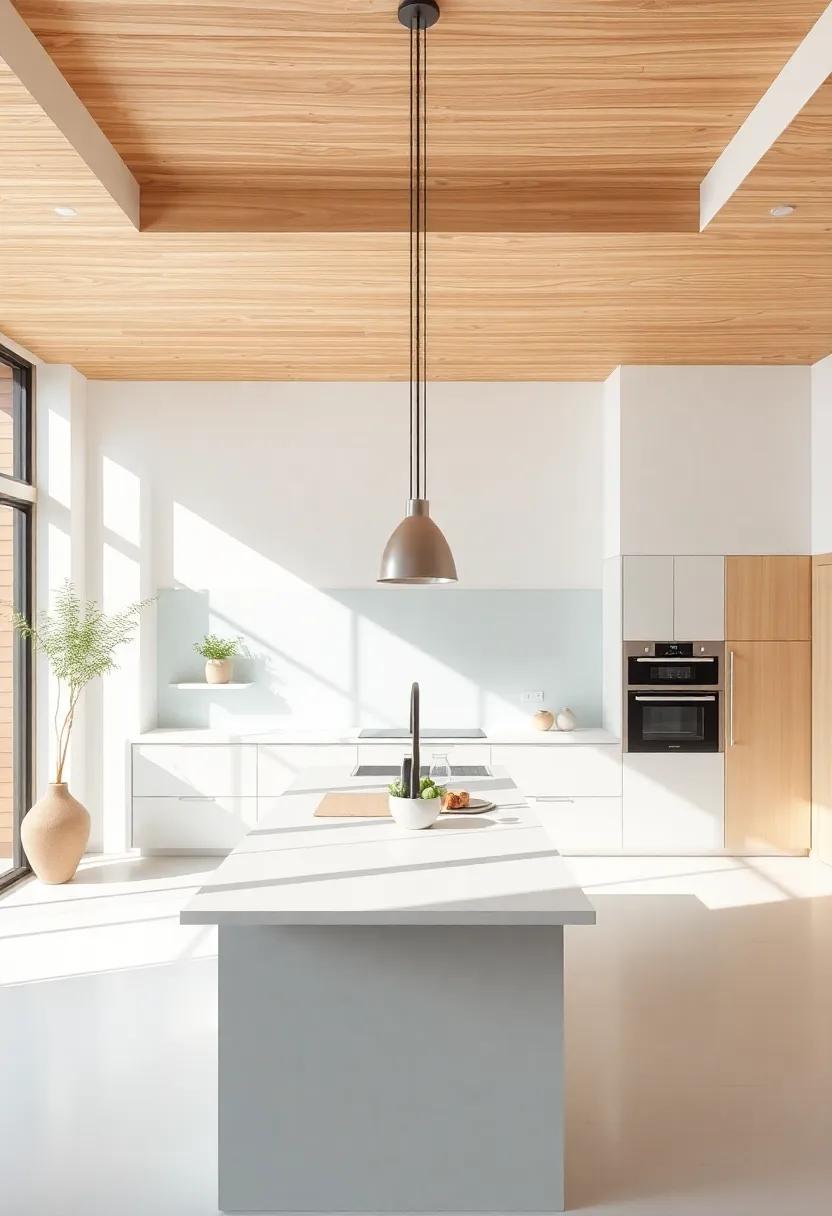
Transforming a modern kitchen into a visually captivating culinary haven involves infusing artistic elements that stimulate the senses and enhance the overall atmosphere. when it comes to incorporating charm, consider adding features such as colorful backsplash tiles, handcrafted cabinetry, or artistic lighting fixtures. Each of these elements not only serves a functional purpose but also acts as a focal point, drawing the eye and invoking a sense of style. Embrace open shelving to display carefully curated dishware or culinary art, creating an inviting environment for both cooking and entertaining.
Integrating textures and patterns can significantly elevate the aesthetic appeal of your kitchen.Opt for a combination of natural materials, such as wood and stone, to bring warmth and authenticity into the space. Additionally, consider small decorative accents, like vintage kitchen tools or a stylish fruit bowl, which can be strategically placed on countertops to reflect personality and creativity. Here’s a quick look at some artistic features to consider:
| Artistic Element | Purpose |
|---|---|
| Colorful Backsplash | Adds vibrant visual interest |
| Handcrafted Cabinetry | Provides unique character |
| Artistic Lighting Fixtures | Enhances ambiance |
| Natural Accents | Brings warmth and depth |
| Decorative Accents | Reflects personal style |
Enhancing the Interaction of Cooking and Dining in Open Spaces

Open spaces allow for a seamless blend of culinary activities and dining experiences, creating an environment that encourages interaction and connection. By designing kitchens that open up into dining areas, families and friends can gather together, cooking while sharing stories and laughter, forging stronger bonds. Picture an island counter that doubles as a buffet, where appetizers are plated and conversations flow effortlessly, led by the enticing aromas wafting from the stove.
To enhance this engagement, consider incorporating key elements that facilitate a harmonious blend of cooking and dining. Strategically placed lighting can highlight various cooking zones, while comfortable seating options can invite guests to linger. A well-organized layout can include:
- Open Shelving: Display beautiful dinnerware and ingredients, encouraging conversation.
- Integrated Technology: Smart kitchen appliances can assist in meal prep, making entertaining easy.
- Multi-functional Furniture: Tables that adjust height or expand can adapt to both cooking and dining needs.
Incorporating these elements not only optimizes the space but transforms the mundane act of cooking into an interactive culinary adventure. Dine beneath a canopy of herbs and greens, bridging the gap between nature and gastronomy. The kitchen becomes not just a place for meal prep but a central hub for socializing, creativity, and unity.
Understanding the Role of Furniture in Kitchen Dynamics

In the realm of modern kitchen design, furniture plays a pivotal role in enhancing both functionality and aesthetics.The open-plan layout invites the incorporation of various pieces that harmonize the cooking and social aspects of this space. Key furniture elements, such as islands, dining tables, and seating, serve not just as practical work areas but also as social hubs where families congregate and entertain. By selecting multi-functional furniture, homeowners can foster an environment that seamlessly transitions from meal preparation to lively gatherings, ultimately redefining how we interact within our kitchens.
Moreover, the choice of materials and finishes can significantly impact the overall atmosphere of the kitchen. Light-colored woods and sleek metals contribute to a feeling of spaciousness, while soft textiles on seating can create warmth and intimacy. Consider these vital elements when designing an open-plan kitchen:
- Color Palette: Neutral tones to enhance the sense of openness
- Furniture Scale: Proportionate sizes to prevent overcrowding
- Style Cohesion: Matching furniture with cabinetry and decor
Incorporating these thoughtful design principles can transform your kitchen into a culinary haven that is both spacious and inviting, encouraging creativity and camaraderie.
Establishing Zones for Preparation, Cooking, and Socializing
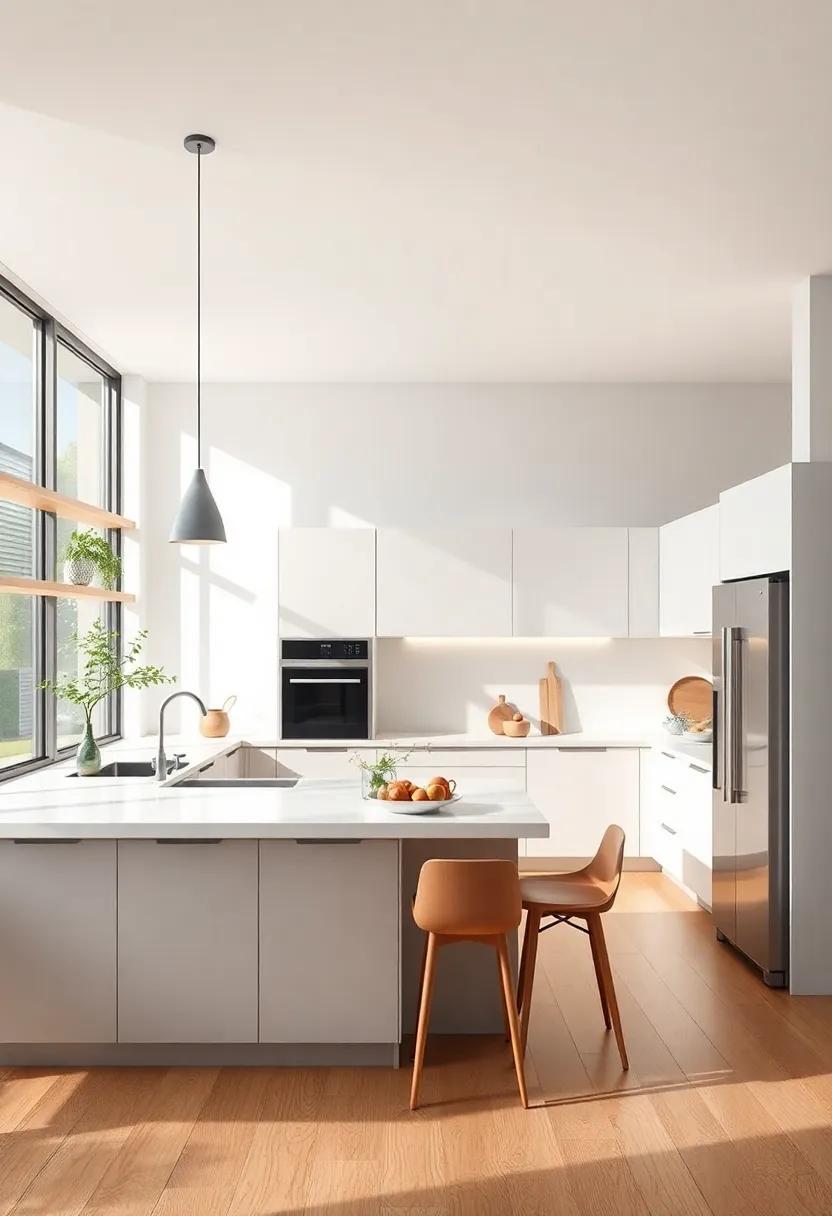
The beauty of an open-plan kitchen lies in its ability to seamlessly integrate functionality with comfort. By carefully designating areas for preparation, cooking, and socializing, you can enhance both the efficiency of your culinary tasks and the enjoyment of shared moments. Kitchen islands and countertops can serve as perfect zones for meal prep,while incorporating dedicated spaces for essential tools ensures that the cooking experience remains uncluttered. Consider the following components for each area:
- Preparation Zone: Ample countertop space, cutting boards, knives, and mixing bowls
- Cooking Zone: Stove, oven, pots, pans, and utensils all within easy reach
- Socializing Zone: Comfortable seating, pendant lighting, and access to snacks and drinks
Each space should flow effortlessly into the next, encouraging interaction while keeping tasks organized. creating visual boundaries, such as barriers or different flooring, can definitely help delineate these zones without sacrificing the overall openness of the design. Consider installing features like open shelving in the cooking zone to display ingredients and utensils, making it easier to grab what you need. An additional table could bridge the preparation and socializing areas for a truly multifunctional experience. below is a simple layout to inspire your design:
| Zone | Key Features |
|---|---|
| Preparation | Spacious countertops, easily accessible knives, and cutting boards |
| Cooking | Centralized stove, hanging pot racks, efficient appliance placement |
| Socializing | Comfortable seating, ambient lighting, proximity to drinks and snacks |
Dedicating a Space for Culinary Exploration and creativity

Transforming a kitchen into a hub of culinary magic requires thoughtful design choices that encourage exploration and creativity. By integrating open shelving and a modular layout, you can create an environment that not only looks stylish but also inspires culinary adventures. Consider incorporating the following elements to enhance your kitchen’s creative potential:
- Flexible Work Areas: Designate zones for different tasks—chopping, baking, and mixing—so that when inspiration strikes, you can move seamlessly from one project to another.
- Inspirational Decor: Adorn your kitchen walls with art or elements that resonate with your personal cooking journey, transforming the space into a gallery of your culinary passions.
- Interactive Technology: Routers and smart displays can offer recipes on demand, making it easy to try out new techniques or cuisines with just a few taps.
Creating a space that breathes creativity involves more than just aesthetics; it also means ensuring your kitchen is equipped with the right tools. An organized and accessible kitchen not only streamlines meal prep but also invites experimentation. Key items to invest in include:
| essential Culinary Tools | Purpose |
|---|---|
| chef’s Knife | For precision and ease in ingredient preparation. |
| Cast Iron Skillet | For versatile cooking, from searing to baking. |
| Food Processor | to simplify intricate tasks like chopping or pureeing. |
| Spice Rack | To encourage flavor exploration and experimentation. |
Focusing on Ergonomics for a User-Friendly Kitchen Environment

Creating an inviting and efficient kitchen space hinges on integrating ergonomic design principles that promote comfort and usability. By prioritizing the needs of the user, homeowners can cultivate a culinary haven that allows for seamless movement and accessibility. Key considerations include:
- Counter Height: Ensure countertops are at a comfortable height for meal preparation, allowing for easy access without the strain of bending.
- Appliance Placement: Position frequently used appliances, like the toaster or coffee maker, within arm’s reach to reduce unnecessary movement.
- Storage Solutions: Incorporate pull-out shelves and lazy Susans to keep essentials within sight and reach, minimizing bending or stretching.
Additionally, an open-plan kitchen design encourages an organized and spacious environment that can greatly enhance the cooking experience. by adopting an open layout, the kitchen can blend seamlessly with dining and living areas, creating an inviting atmosphere for both the chef and guests. To make the most of this synergy, consider the following elements:
- Flow and Accessibility: design pathways that allow for smooth movement between the kitchen and adjoining spaces, promoting social interaction during meal prep.
- Visual Harmony: Choose a cohesive color palette and materials that resonate throughout the open space, ensuring a tranquil yet vibrant atmosphere.
- Multifunctional Islands: Utilize kitchen islands not only for meal prep but also as gathering spots, integrating seating to foster conversation.
Celebrating Minimalism in Open Plan Kitchen Designs
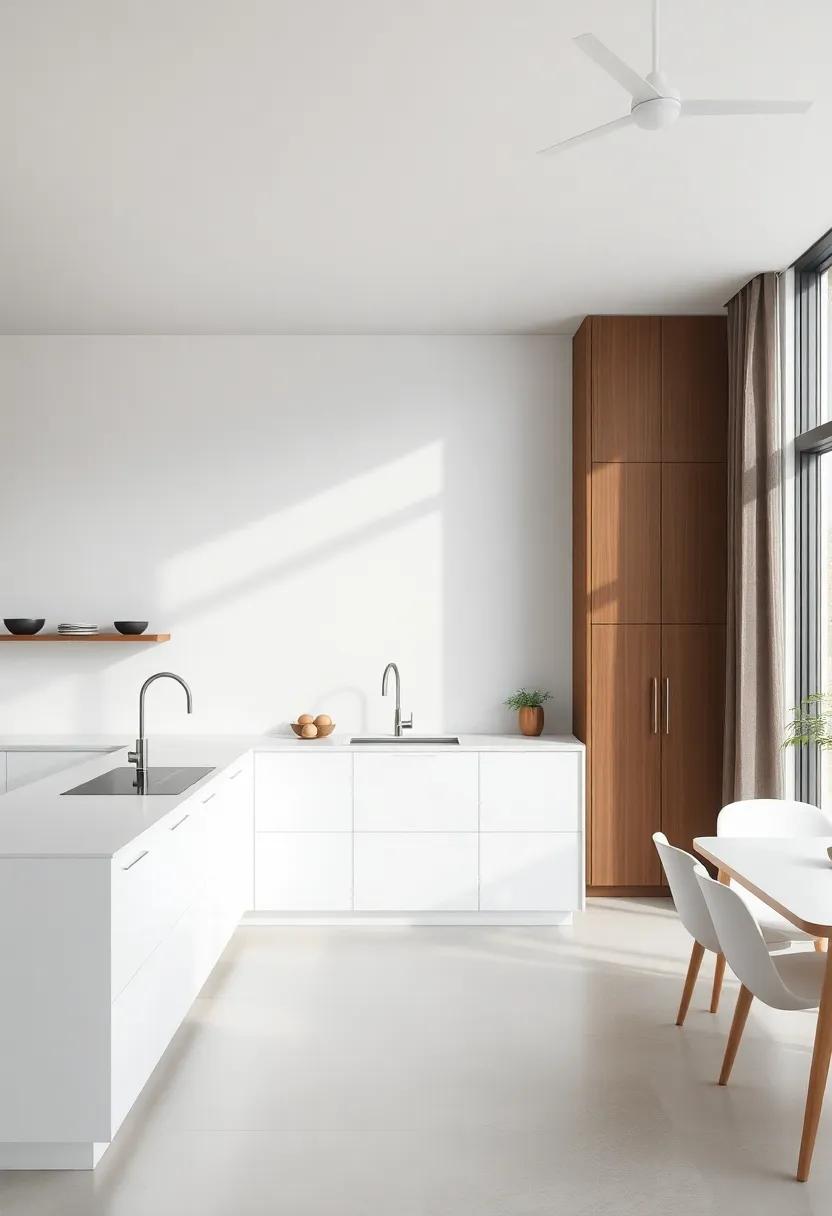
Minimalism in open plan kitchen designs allows for a seamless flow of space, merging the culinary realm with living areas and creating a sense of tranquility. By stripping away the superfluous, these spaces embrace clean lines and functional aesthetics, fostering an environment where cooking becomes an enjoyable social affair. Essential elements, such as cabinetry and appliances, are frequently enough streamlined to enhance the sense of openness, while maintaining a focus on usability and practicality. this design philosophy highlights a curated selection of materials,colors,and textures that work in harmony,encouraging balance and unity throughout the kitchen.
key characteristics often found in minimalist open plan kitchens include:
- Natural Materials: Wood, stone, and metal elements create warmth and texture.
- Soft Color Palettes: Neutral tones like whites, grays, and beiges promote an airy ambiance.
- Integrated Technology: Appliances that blend seamlessly within cabinetry help maintain uncluttered visuals.
- intuitive Layout: An open arrangement encourages interaction, making cooking a communal experience.
To further highlight the importance of minimalism, consider how these kitchens can maximize storage while minimizing visual clutter. The table below showcases different storage solutions that enhance functionality without compromising the aesthetic appeal of the space:
| Storage Solution | Description |
|---|---|
| Pull-Out Pantries | Utilizes narrow spaces for easy access to dry goods. |
| Hidden Cabinets | Maintains a sleek surface, hiding appliances and utensils. |
| Floating Shelves | Offers display options for decorative items while keeping counters clear. |
| Under-Counter Drawers | Maximizes lower cabinet space, keeping essentials organized and out of sight. |
Embracing Flexibility in Furniture Arrangement for diverse Occasions
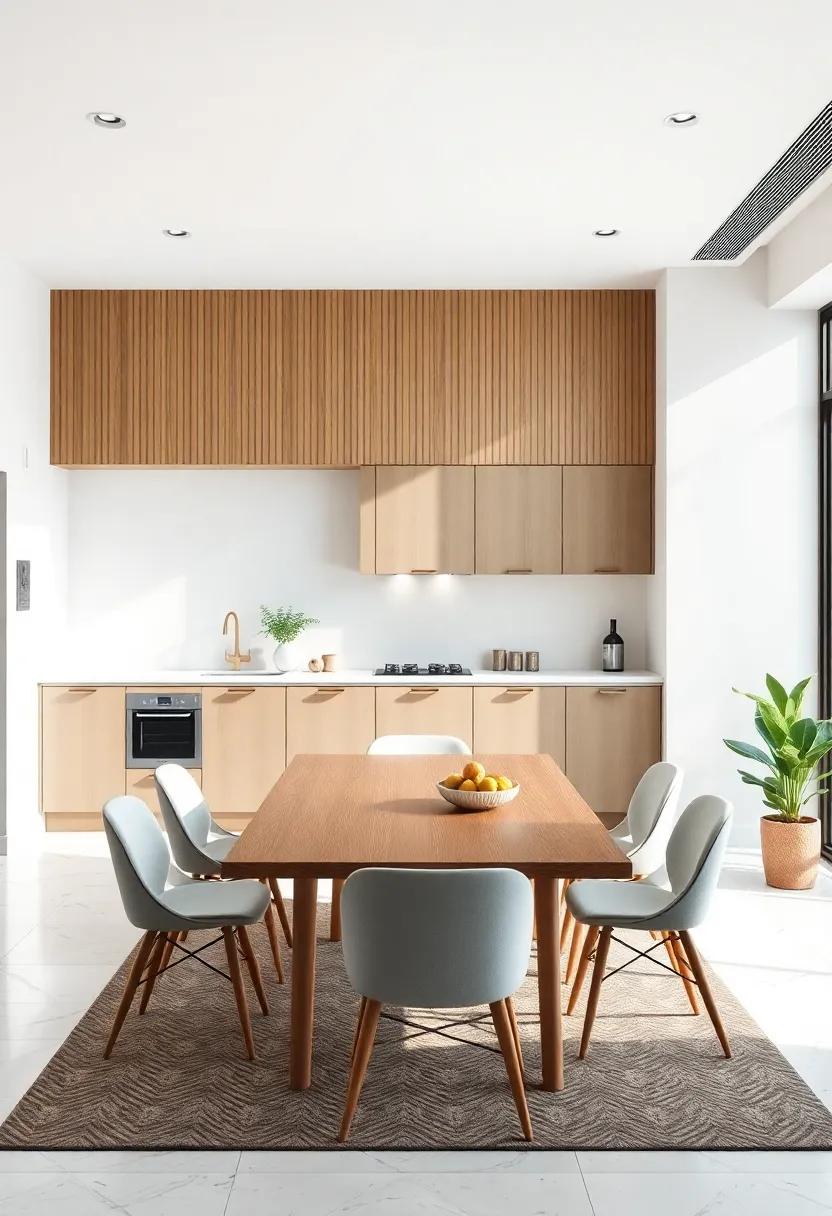
One of the remarkable aspects of modern kitchens is their ability to adapt to various social settings and daily activities.Embracing flexibility in furniture arrangement allows homeowners to transition seamlessly between intimate family gatherings and lively dinner parties. Consider versatile pieces that can serve multiple functions. Such as, a large kitchen island topped with bar stools can double as a casual dining space during weekdays and transform into a buffet style setup for weekend entertainment. Incorporating movable carts adds even further adaptability, enhancing the flow of conversations and interactions within the space.
Moreover, the inclusion of modular furniture invites creativity and personal expression into kitchen design. Investing in pieces that can be reconfigured based from time to time makes all the difference. Some options to explore include:
- Expandable tables for larger gatherings
- Stackable chairs to save space when not in use
- Rolling islands that can be repositioned as needed
These solutions not only maximize utility but also enhance visual appeal, ensuring that the kitchen remains a vibrant hub of activity, regardless of the event or meal being served.
To Conclude
the open plan kitchen is more than just a design trend; it is a transformative approach that redefines how we experience culinary spaces. By embracing this innovative layout, we open doors to a world of possibilities—where cooking becomes a communal experience and family gatherings flourish in an atmosphere of connectivity. As we navigate our kitchens daily, let us celebrate the seamless flow of open spaces that invite collaboration, creativity, and comfort. The modern kitchen is not merely a place for meal preparation; it is a vibrant hub of daily life, where memories are crafted alongside gourmet dishes. So, whether you’re considering a renovation or simply dreaming of a more open space, remember that the key to a truly inviting kitchen lies in its ability to foster connection, both with the food we create and the loved ones we cherish. Embrace the open plan, and transform your kitchen into a haven of culinary adventure and warmth.
As an Amazon Associate I earn from qualifying purchases.

